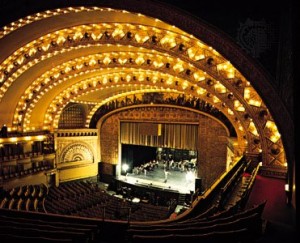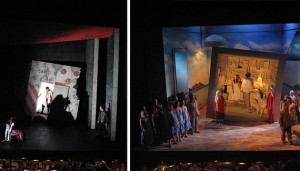Annotated Bibliography 6 : Unit Two
“Resources_IdeasInfo_typesandformsoftheatre.pdf.” Web. 20 Feb. 2016.
In their article, “Types and Forms of Theatre”, Theatre Projects Consultants, a group of specialists who build performance spaces, claim that, “There is no ideal size of a theatre [because] the scale of a theatre depends on the size of the staging required by the type of performance and the number of audience to be accommodated, with each variable influencing the other as they change.” To support their claim, they explain the different types of performance spaces and the purpose of each type. The types of spaces they describe are drama, music, opera, dance,multipurpose, worship, teaching, media interaction and entertainment. To further explain, they give detailed descriptions of each type and provide examples of these theaters from various cities. The purpose of this article is to explain the different types of theater set-ups and their purposes. It will be a useful source to someone that wants to know about how the function of a theater influences its design.
Annotated Bibliography 5: Unit Two
“Theatre Design – The Goals of Theatre Design | Architecture.” Encyclopedia Britannica. N.p., n.d. Web. 19 Feb. 2016.
In their article, “Theatre Design – The Goals of Theatre Design”, the editors of Encyclopedia Britannica, a global educational publisher, they claim that “Theatre design is primarily concerned with enhancing the experience the audience can have at a performance [and] the specific architectural elements considered ideal for improving that experience will differ from culture to culture and sometimes even between subcultures within a given culture.” To support this claim, they describe two different categories of elements in a design, each being used for a different purpose. The two categories are “those that serve the aesthetics deemed appropriate for the art of theatre in a given culture, and those that optimize the experience of that art for the audience.” In the article they provide information on each of them, stating that “Those elements that serve the aesthetics of the art of theatre can involve everything from what the performers need to reach the artistic standards deemed proper before a performance starts to what they need to support the required amount of spectacle during performance, whether it be a bare stage or a stage with enormous movable sets and a spectacular array of props.” In contrast, “The elements that are most often discussed in terms of optimizing the experience had by the audience revolve around audience comfort”. Then they explain which areas of the theatre fit in each category. They state that, “those elements of a theatre’s design that serve primarily to optimize the experience of the audience are the house and the… ‘front-of-house’ facilities” and “those elements of the design of a theatre that serve primarily the aesthetics of theatre performance are the stage and the…backstage spaces”. They then describe each area in detail. The purpose of this article is to provide information on the purposes of theater design. This will be a useful source for someone that is interested in finding out why theaters are designed a certain way.
Annotated Bibliography 4: Unit Two
Lehman, Maria Lorena. “Take Note When Experiencing Theater Set Design.” Sensing Architecture ® Academy | Maria Lorena Lehman. N.p., 7 Dec. 2009. Web. 20 Feb. 2016.
In her article, “Take Note When Experiencing Theater Set Design”, Maria Lehman, an architectural author, designer and educator, claims that “theater set design must work to create an experience with space, and often such theatrical experiences tap into so much more that just the visual sense.” To support her claim, she gives explains how the environment of the theater set is used to engage the audience in the show. In the article, Lehman states that ” a theater stage (say for a musical) can be perceived as a micro-environment in that it must accomplish a lot with a little amount of space.” She suggests architects to consider how the limited space of the stage affects the transitions in a performance. The purpose of this article is to raise encourage architects to “keep in mind how the set design experience really caters to the senses.” This would be a useful source to someone that is interested in learning about the importance of the set up of the stage in a theater and how the size of the stage affects the performance.
Is It Gender Neutral? : A Summary of Susan Tick’s Article
According to Susan Tick’s article,“His & Hers: Designing for a Post-Gender Society”, “today’s design landscape is deeply rooted in Modernism, a movement shaped by a predominately male perspective.” She argues for a change in this design to make it more “gender-neutral”. She suggests for designers to learn more about “society’s issues” and apply what they have learned to their designing process. An example of this is the design of the “workplace.” Today in the workplace, the “barriers and hierarchies” ,due to gender, are beginning to fade away. Women are taking more leadership roles in the workplace, challenging the “gender roles” that were once there. There is also the “new wave of feminism” and the LGBT rights movement challenging this concept. Tick states that people are now “craving more softness in interiors, with the open plan, the influence of hospitality, and and emphasis on tactile and textural materials.” Then she argues that this would be the best time for designer to think about “how they incorporate gender sensitivity in to their work.”
After discussing the workplace, Tick explains the “human phenomenon” of “masculine and feminine definitions being switched and obscured.” Examples of this can be found in fashion, which “embraces” this idea. She provides an examples of this by talking about the “military look” of “Alexander Wang’s women’s coat from Fall 2015” and Annemiek van deer Beek’s make-up line for men.
Tick also argues that “Gender roles” cause “outward appearances” to be confusing. Although people are assigned a certain gender at birth, they are allowed to decide what gender they identify” as. In fact, there are some college with students refusing to put their gender down on forms because they don’t want to be “identified” as male or female. There are even middle school children doing the same. Some schools are okay with this, and Tick encourages designers to keep up with these “trends.” She said that the view of transgender people has changed and provides an example of this. According to Tick, Maritine Rothblatt, CEO of United Therapeutics became the “highest paid female executive in the United States even though she was born biologically a male.”
Towards the end of the article, Tick talks about some of the changes that have been made so far, like the “gender-neutral or unisex bathrooms” at Google and provides an example of a time where these types of bathrooms would have been useful. Her example was a case where a worker had a “gender-reassignment surgery” done over their break. Apparently, the coworkers were not okay with this person using the bathrooms, because of and She explains the importance of “making people feel accommodated”,not only in the bathrooms, but everywhere. This leads to the subject of Americans with disabilities and how they also experience a disadvantage, but Tick says that “gender issues” can not be handled to same way that their issues are handled, with “regulations and compliance.”It also will take time, considering “we are only at the very beginning with gender-neutral design.”


